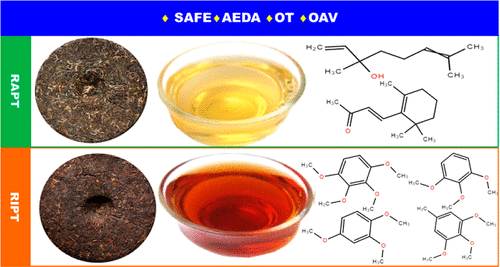当前位置:
X-MOL 学术
›
J. Agric. Food Chem.
›
论文详情
Our official English website, www.x-mol.net, welcomes your
feedback! (Note: you will need to create a separate account there.)
Comparison of Potent Odorants in Raw and Ripened Pu-Erh Tea Infusions Based on Odor Activity Value Calculation and Multivariate Analysis: Understanding the Role of Pile Fermentation.
Journal of Agricultural and Food Chemistry ( IF 5.7 ) Pub Date : 2019-11-14 , DOI: 10.1021/acs.jafc.9b05321
Xueli Pang 1 , Weisong Yu 1 , Changdai Cao 2 , Xiaoxiang Yuan 3 , Jun Qiu 1 , Fanyu Kong 1 , Jihong Wu 4
Journal of Agricultural and Food Chemistry ( IF 5.7 ) Pub Date : 2019-11-14 , DOI: 10.1021/acs.jafc.9b05321
Xueli Pang 1 , Weisong Yu 1 , Changdai Cao 2 , Xiaoxiang Yuan 3 , Jun Qiu 1 , Fanyu Kong 1 , Jihong Wu 4
Affiliation

|
Infusions prepared from raw pu-erh tea (RAPT) and ripened pu-erh tea (RIPT) showed remarkable aroma differences. Predominant odorants in RAPT and RIPT infusions were identified and compared by the combined use of gas chromatography-olfactometry, aroma extract dilution analysis, odor activity values (OAVs), and multivariate analysis. A total of 35 and 19 odorants (OAV > 1) were detected in RIPT and RAPT, respectively. Odorants in RAPT and RIPT are significantly different in both odor properties and aroma compound intensities. Overall, RAPT contained a complex variety of chemical classes with diverse odors and moderate odor intensities, while RIPT is dominated by structurally and organoleptically similar compounds with high potency. Specifically, stale and musty smelling methoxybenzenes contributed the most to RIPT, while floral-, sweet-, and woody-smelling terpene alcohols, terpene ketones, and phenolic compounds were the predominant odorants in RAPT. Orthogonal partial least squares discriminant analysis revealed that linalool, α-ionone, 1,2,4-trimethoxybenzene, 1,2,3-trimethoxy-5-methylbenzene, 1,2,3,4-tetramethoxybenzene, and 1,2,3-trimethoxybenzene underwent remarkable changes during pile fermentation and could be used as potential odor-active markers for RIPT and RAPT discrimination. The comprehensive aroma characterization of pu-erh tea and determination of the effect of pile fermentation on odorant alteration herein will provide guidance for pu-erh tea flavor quality control and evaluation.
中文翻译:

基于气味活度值计算和多元分析的普Pu茶生茶和熟茶中强效气味比较:了解堆发酵的作用。
用普茶(RAPT)和普ned茶(RIPT)制成的浸泡液显示出明显的香气差异。通过结合使用气相色谱-嗅觉测定法,香气提取物稀释分析,气味活性值(OAVs)和多变量分析,确定并比较了RAPT和RIPT输液中的主要气味。在RIPT和RAPT中分别检测到35种和19种气味剂(OAV> 1)。RAPT和RIPT中的气味在气味特性和芳香化合物强度上都存在显着差异。总体而言,RAPT包含多种化学类别,具有不同的气味和中等的气味强度,而RIPT主要由结构和感官上相似的高效化合物主导。具体而言,陈旧和发霉的甲氧基苯气味对RIPT的贡献最大,而花香,甜味,木质气味的萜烯醇,萜烯酮和酚类化合物是RAPT中的主要气味物质。正交偏最小二乘判别分析表明,芳樟醇,α-紫罗兰酮,1,2,4-三甲氧基苯,1,2,3-三甲氧基-5-甲基苯,1,2,3,4-四甲氧基苯和1,2,3 -三甲氧基苯在堆发酵过程中发生了显着变化,可以用作RIPT和RAPT鉴别的潜在气味活性标记。本文对普-茶的香气进行了全面的表征,并确定了堆发酵对香气变化的影响,将为普flavor茶的风味质量控制和评估提供指导。α-紫罗兰酮,1,2,4-三甲氧基苯,1,2,3-三甲氧基-5-甲基苯,1,2,3,4-四甲氧基苯和1,2,3-三甲氧基苯在堆发酵过程中发生了显着变化,并可能用作RIPT和RAPT鉴别的潜在气味活性标记。本文对普-茶的香气进行了全面的表征,并确定了堆发酵对香气变化的影响,将为普flavor茶的风味质量控制和评估提供指导。α-紫罗兰酮,1,2,4-三甲氧基苯,1,2,3-三甲氧基-5-甲基苯,1,2,3,4-四甲氧基苯和1,2,3-三甲氧基苯在堆发酵过程中发生了显着变化,并可能用作RIPT和RAPT鉴别的潜在气味活性标记。本文对普-茶的香气进行了全面的表征,并确定了堆发酵对香气变化的影响,将为普flavor茶的风味质量控制和评估提供指导。
更新日期:2019-11-14
中文翻译:

基于气味活度值计算和多元分析的普Pu茶生茶和熟茶中强效气味比较:了解堆发酵的作用。
用普茶(RAPT)和普ned茶(RIPT)制成的浸泡液显示出明显的香气差异。通过结合使用气相色谱-嗅觉测定法,香气提取物稀释分析,气味活性值(OAVs)和多变量分析,确定并比较了RAPT和RIPT输液中的主要气味。在RIPT和RAPT中分别检测到35种和19种气味剂(OAV> 1)。RAPT和RIPT中的气味在气味特性和芳香化合物强度上都存在显着差异。总体而言,RAPT包含多种化学类别,具有不同的气味和中等的气味强度,而RIPT主要由结构和感官上相似的高效化合物主导。具体而言,陈旧和发霉的甲氧基苯气味对RIPT的贡献最大,而花香,甜味,木质气味的萜烯醇,萜烯酮和酚类化合物是RAPT中的主要气味物质。正交偏最小二乘判别分析表明,芳樟醇,α-紫罗兰酮,1,2,4-三甲氧基苯,1,2,3-三甲氧基-5-甲基苯,1,2,3,4-四甲氧基苯和1,2,3 -三甲氧基苯在堆发酵过程中发生了显着变化,可以用作RIPT和RAPT鉴别的潜在气味活性标记。本文对普-茶的香气进行了全面的表征,并确定了堆发酵对香气变化的影响,将为普flavor茶的风味质量控制和评估提供指导。α-紫罗兰酮,1,2,4-三甲氧基苯,1,2,3-三甲氧基-5-甲基苯,1,2,3,4-四甲氧基苯和1,2,3-三甲氧基苯在堆发酵过程中发生了显着变化,并可能用作RIPT和RAPT鉴别的潜在气味活性标记。本文对普-茶的香气进行了全面的表征,并确定了堆发酵对香气变化的影响,将为普flavor茶的风味质量控制和评估提供指导。α-紫罗兰酮,1,2,4-三甲氧基苯,1,2,3-三甲氧基-5-甲基苯,1,2,3,4-四甲氧基苯和1,2,3-三甲氧基苯在堆发酵过程中发生了显着变化,并可能用作RIPT和RAPT鉴别的潜在气味活性标记。本文对普-茶的香气进行了全面的表征,并确定了堆发酵对香气变化的影响,将为普flavor茶的风味质量控制和评估提供指导。

































 京公网安备 11010802027423号
京公网安备 11010802027423号